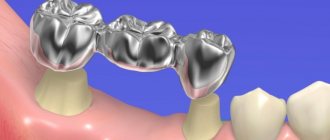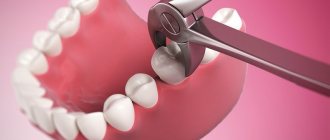- Home » Articles » Is it necessary to depulp a tooth under a crown?
14 September 2021
A dental crown is a prosthetic solution that allows the restoration of severely damaged teeth in situations where reconstruction cannot be performed with a composite material. Crowns can be made of metal ceramics, solid ceramics or zirconium (the most popular options). But they have one thing in common: a properly made crown can serve patients as long as a natural tooth. And the basis of proper manufacturing is proper preparation for prosthetics.
How we do it at Amazing Price Dentistry:
PROMOTION
Dental restoration, installation of fillings
from 2200 rub.
Is it worth putting a crown on a dead tooth?
Sometimes a diseased tooth has to be depulped, which is due to the ineffectiveness of therapeutic treatment of pulpitis. Whether it is worth doing depulpation before installing a crown on a tooth, only the doctor decides based on clinical indications.
The tooth receives all nutrition through the neurovascular bundle, so after its removal only dentin and enamel remain. Dead dentin tissue begins to darken, the tooth becomes fragile and gradually carious deposits form in it, which can spread to neighboring units.
Installing a prosthesis solves two problems at once - maintaining aesthetics and preventing the destruction of a pulpless tooth.
Knowledge and experience of orthopedists
Of great importance in the issue of prosthetics without depulpation is the knowledge of orthopedic doctors about the safety zones of the crown parts of teeth. Safety zones are those areas of the tooth within which you can safely grind the tooth tissue without damaging the pulp.
The canines have slightly more such tissue than the lateral incisors. The age of the patient is also important: the older the person, the less likely the pulp is to be damaged.
Contact our clinic for a consultation on prosthetics without depulpation, and we will definitely find the right solution for you!
Dental prosthetics in our clinic. Types of dental crowns and methods of their manufacture
Prosthetics on “living” teeth
However, with a sufficiently preserved volume of the coronal part of the tooth and an intact nerve, if it is necessary to make a bridge structure, as well as if it is necessary to correct the shape of the tooth, it is possible and necessary to keep the teeth vital (alive).
The classic metal-ceramic crown, widely used in practice by orthopedic dentists, is a combined two-part crown - the frame (cap) of the crown consists of a metal alloy, onto which ceramic mass is applied layer by layer. The technology requires abrasion of a sufficient amount of hard tissue, which is an extremely invasive technique.
Currently, all-zirconium crowns, the so-called, have become widespread. prettau technology (one-piece, without ceramic lining). The advantages of such crowns over classic metal-ceramic crowns are that during preparation a minimum amount of hard tooth tissue is ground off, which, in turn, allows the orthopedic dentist to carry out minimally invasive intervention, does not take the patient out of the comfort zone, and also allows the tooth to be kept vital ( alive).
Doctor of Medical Sciences orthopedist dentist Leonid Yakovlevich Koussevitzky
Sources:
- Samoilenko L. A. Depulpation of teeth in some diseases of the dental system, 1970
- Federal Agency for Technical Regulation and Metrology. Patient management protocol. Partial absence of teeth (partial secondary adentia), 2009
Expert author:
Avdeeva Tatyana Dmitrievna
Dentist-therapist
The information presented in this article is provided for reference purposes and does not replace the advice of a qualified specialist.
At the first signs of illness, you should consult a doctor.
Tell us about us:
Installing a crown on the sixth tooth
Contrary to popular belief, the first permanent teeth that emerge in humans are molars (we call them sixes). They bear the main chewing load. Due to some reasons: poor hygiene or lack of it at all, untimely treatment, and so on, caries forms and, as a result, tooth decay.
Filling a tooth with a high functional load is not cost-effective and ineffective. Chewing hard foods can cause fillings and tooth walls to crack. Therefore, the best option is to install a crown. It will completely restore the chewing function of the tooth and protect it from further destruction.
The method of prosthetics for the sixth tooth depends on the clinical picture, and the decision is made by the orthopedist. If the tooth decay is severe, then I usually recommend removing the molar and then installing a pin onto which the crown is attached.
If the tooth can be saved, then prosthetics occurs according to the following algorithm:
- Inspection and diagnostics.
- Complete sanitation of the oral cavity is a mandatory procedure, the implementation of which determines the quality of prosthetics. The slightest presence of infection in the patient’s mouth can provoke the emergence of infectious foci in the prosthetic area.
- Tooth preparation, impression taking.
- Fixation of a permanent crown.
Some people think that it is possible to expect the production of a prosthesis with grinded teeth without temporary plastic crowns - such as as long as it takes, if you do not eat too hard food. No and no again! The ground tooth/teeth must be covered with temporary crowns! Typically, the waiting time for permanent crowns and wearing temporary ones is one to two weeks.
When choosing a material for a prosthesis, you need to take into account: where you want to place the crown and the functional feature of the tooth, therefore, to create a crown for the sixth tooth, it is better to use a material with high strength values.
Do no harm
A patient consulted a doctor with one missing tooth and nearby intact teeth with a high crown.
Upon completion of prosthetics, the patient received a metal-ceramic prosthesis and two pulpless, heavily ground teeth. Such cases come across often. There is another way, the right way - do not depulpate the supporting teeth unnecessarily. This path is more complex, requiring more accuracy, caution, additional materials and a more respectful attitude towards the patient and his teeth. Often patients have the question “Why is it necessary to remove nerves from healthy teeth before prosthetics?” To tell the truth, this is not a mandatory procedure at all. When a patient comes without any complaints and is offered to turn “living” teeth into “dead” ones, deliberately changing their status from “healthy” to “previously treated”, this cannot but cause bewilderment in the patient.
On the other hand, why should the patient pay for such work? And in general, how to justify the need for such “treatment”? What “diagnosis” should be made before performing endodontic treatment on a healthy tooth?
And where is the guarantee that dental treatment will be successful and the doctor will not have to accept claims in the near future? Even with an arsenal of modern endodontic instruments, materials, ultrasonic devices, and sufficient practical skills, it is not always possible to achieve the desired effect.
It is also known that teeth without nerves, called “dead”, become fragile, more susceptible to destructive processes of hard tissues, their shock-absorbing function changes, especially after the widely used resorcinol-formalin method, and this does not bode well for patients.
For dental prosthetics without depulpation, we provide an extended 3-fold guarantee.
Contraindications for depulpation
When is it impossible to remove a dental nerve?
- stomatitis, inflammatory, purulent processes in the oral cavity;
- cardiovascular diseases;
- ARVI, sore throat, influenza;
- infectious hepatitis;
- hemorrhagic diathesis;
- acute leukemia;
- psychoemotional disorders;
- pregnancy.
Depulpation methods. How is the dental nerve removed?
Vital method
The vital depulpation method is used in adults and children - for all forms of pulpitis. This is a one-session procedure performed under local anesthesia. The dentist prepares the tooth, removes the pulp, cleans and fills the root canals, and then places a filling.
Devital method
The devital depulpation method is used to completely remove the coronal and root parts of the pulp. It differs from the vital method in the duration of treatment. An arsenic-free paste is applied to the pulp, after which a temporary filling is installed. The permanent filling is installed at your next visit to the dentist. In modern clinics, this method of treatment is used less and less.
Regardless of the method, the depulpation procedure is always carried out under anesthesia and the use of x-ray control of the tooth before and after depulpation. In 99% of cases, the vital method is used, in which complete, painless dental treatment can be completed in just one visit to the doctor.
From the history of depulpation or how were dental nerves removed before?
Depulping with arsenic is an outdated, quite painful and time-consuming method. The essence of depulpation with arsenic is that the dentist, using a dental drill, expands the root canal of the diseased tooth, opening direct access to the pulp. Then arsenic is placed in the canal and the tooth is covered with a temporary filling. Within a few days, arsenic affects the pulp, causing its death. A few days later, the patient visits the dentist again, who removes the temporary filling and removes the dead nerve from the canal. Then the dentist cleans the root canal and places a permanent filling. If the tooth continues to hurt after removing the nerve, the nerve may not have been completely removed. If pain after depulpation is caused by improper treatment and/or poor-quality canal treatment, the patient needs to visit the dentist again.
One of the main disadvantages of depulping with arsenic is its unsafety. With prolonged contact with a tooth, arsenic can lead to its complete destruction, because Arsenic is a poison, so arsenic paste was applied for a short period of time.
In modern dentistry, preference is given to safer methods of pulp removal.
Features of depulpation
Features of depulpation of baby teeth
It happens that pulpitis develops on baby teeth in children. In children, the depulpation procedure has its own characteristics:
- The minimum dosage of anesthesia is safe for the child;
- Careful opening of the crown;
- The most careful removal of the nerve ending, so as not to damage the primary processes of the molars;
- Thorough disinfection after depulpation to avoid re-inflammation;
- A filling for a baby tooth (based on mummifying compounds) – gives a disinfecting effect.
Depulpation of wisdom teeth
The difficulty of removing nerves from wisdom teeth lies in the inaccessibility of the teeth and the complexity of the structure of their canals. Therefore, if inflammatory processes occur in the pulp of wisdom teeth, it is better to remove the wisdom teeth.
Possible complications of depulpation
Complications that may arise after depulpation appear for 2 reasons:
- Anatomical features of dental canals and pulp.
- Incorrectly performed depulpation procedure.
Anatomical features of dental canals and pulp
Often the dental canals are very curved, in such cases access to the pulp can be difficult and it is difficult for the dentist to reach the nerve. In this regard, the pulp may not be completely removed, or cavities may remain in the canals.
The use of X-rays allows us to study the shape of the canals before removing the nerve and select the most appropriate instruments, which minimizes the likelihood of the above-mentioned treatment complications.
Incorrectly performed depulpation procedure
- Careless cleaning of the canals will preserve and intensify the inflammatory process due to incomplete removal of damaged tissue.
- Using an inappropriate pulp extractor channel size or improper handling of the instrument.
- Broken dental instrument, retention of its remains in the dental canal (this error may lead to the need to remove the tooth).
- Residual pulpitis occurs against the background of incompletely removed pulp.
- Perforation of root walls;
- Allergic reaction to filling material.
Poor disinfection of the canal when removing the nerve can trigger the process of suppuration. Which, in the absence of adequate treatment, can develop into a periodontal abscess. Such a complication leads to the need for tooth extraction.
Other possible complications:
Painful sensations for several days after depulpation - the duration is individual for everyone. If pain persists for a long time, it is necessary to consult a doctor to re-open the canals and carry out disinfection.
Specific problems can arise if the material is applied incorrectly: if the filling extends beyond the boundaries of the root apex, the jaw nerve may be pinched.
Recommendations
Recommendations after depulpation:
- refuse, for at least 2 hours, increased physical activity;
- rinse your mouth with antiseptics prescribed by your doctor during the day;
- hold off on eating for the first 3 hours (drink boiled, warm water through a straw);
- give up smoking and alcohol for five days, also do not take (solid, hot/cold, spicy) foods that cause irritation of the mucous membrane;
- It is forbidden to drink cold drinks, ice cream, or apply ice to the affected area.
Cost of tooth depulpation (depulpation)
How much does it cost to depulp an upper front or lower back tooth?
The cost of tooth removal in Moscow on a turnkey basis depends on the following factors:
- microscope applications
- dentist qualifications
- pricing policy of the dental clinic.
- High-quality dentistry in Moscow
- Israeli Adin implants
- All-on-4 dental implantation
- All-on-6 implantation
- Israeli implants Alpha Bio
- Alternative to Dental Implants
- American dental implants
- German Ankylos implants
- Dental implantation for bone tissue atrophy
- Basal dental implantation
- Partial dental implantation
- Professional cleaning of dental implants
- Cleaning your teeth before installing implants
- Dental implantation or dentures: which is better?
- Korean Dentium implants
- Cheap dental implants
- Two-stage dental implantation
- Express dental implantation
- German ICX implants
Request a call back or dial our number!
+7
This phone call does not obligate you to anything. Just give us a chance and we will help you!
Just pick up the phone and call us!
+7
We will definitely make you an offer that you cannot refuse!










